Social Divisions and Social Groups: Gender Inequality & Health
VerifiedAdded on 2023/06/11
|10
|3380
|386
Essay
AI Summary
This essay examines gender as a significant social division, focusing on its impact on health. It discusses how gender inequality manifests in various aspects of life, with women historically occupying subordinate positions. The essay highlights feminist perspectives, particularly gender feminism, which views gender differences as socially constructed mechanisms for maintaining male dominance. It explores how socialization processes, including parental influence and media representation, reinforce gender stereotypes. Furthermore, the essay analyzes the repercussions of gender inequality on health, noting disparities in healthcare access and treatment, as well as the societal stigmatization of illnesses. It concludes by emphasizing the need for social reforms to address gender-based discrimination and improve health outcomes. Desklib offers a wide range of academic resources, including essays and solved assignments, to support students in their studies.
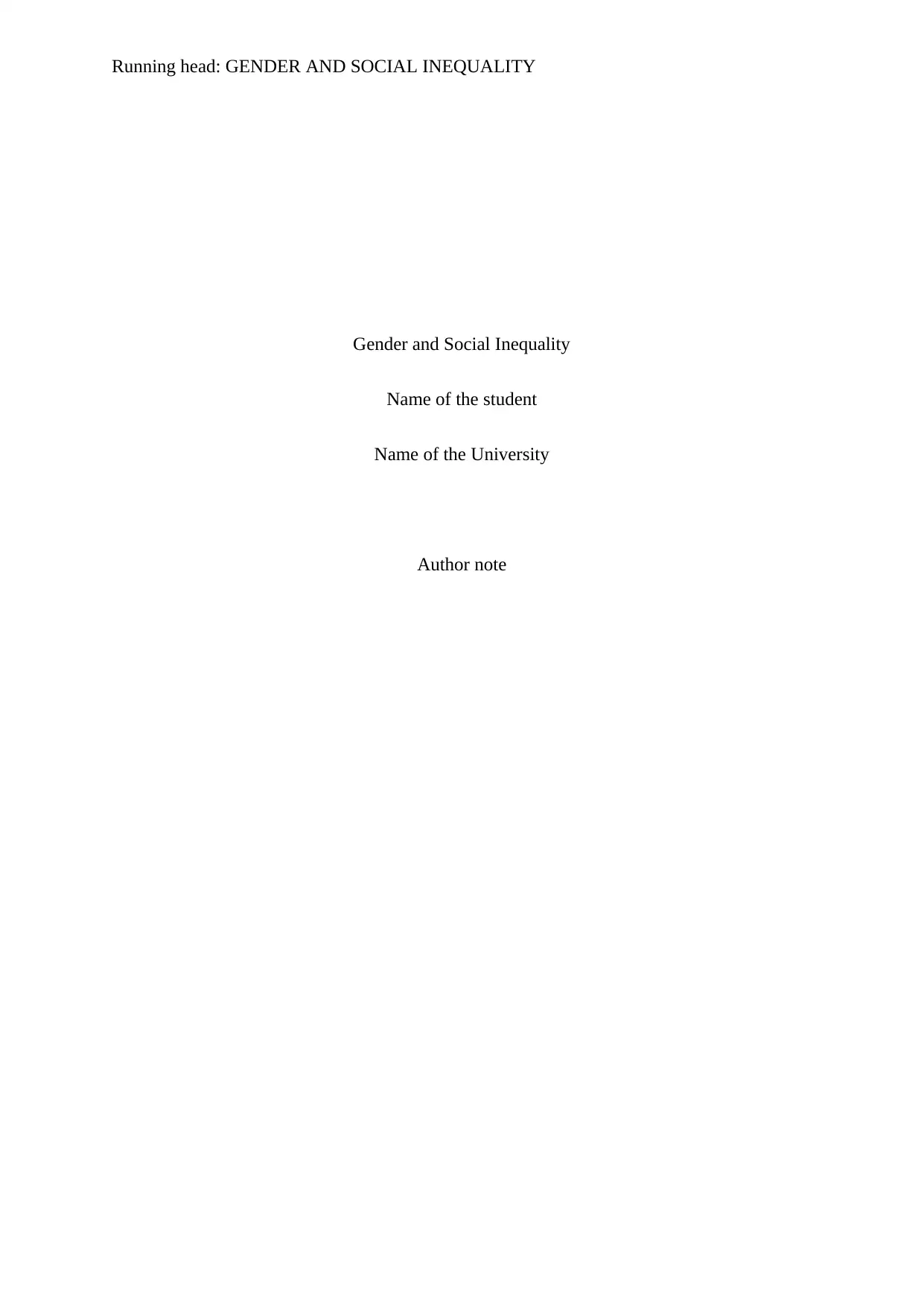
Running head: GENDER AND SOCIAL INEQUALITY
Gender and Social Inequality
Name of the student
Name of the University
Author note
Gender and Social Inequality
Name of the student
Name of the University
Author note
Paraphrase This Document
Need a fresh take? Get an instant paraphrase of this document with our AI Paraphraser
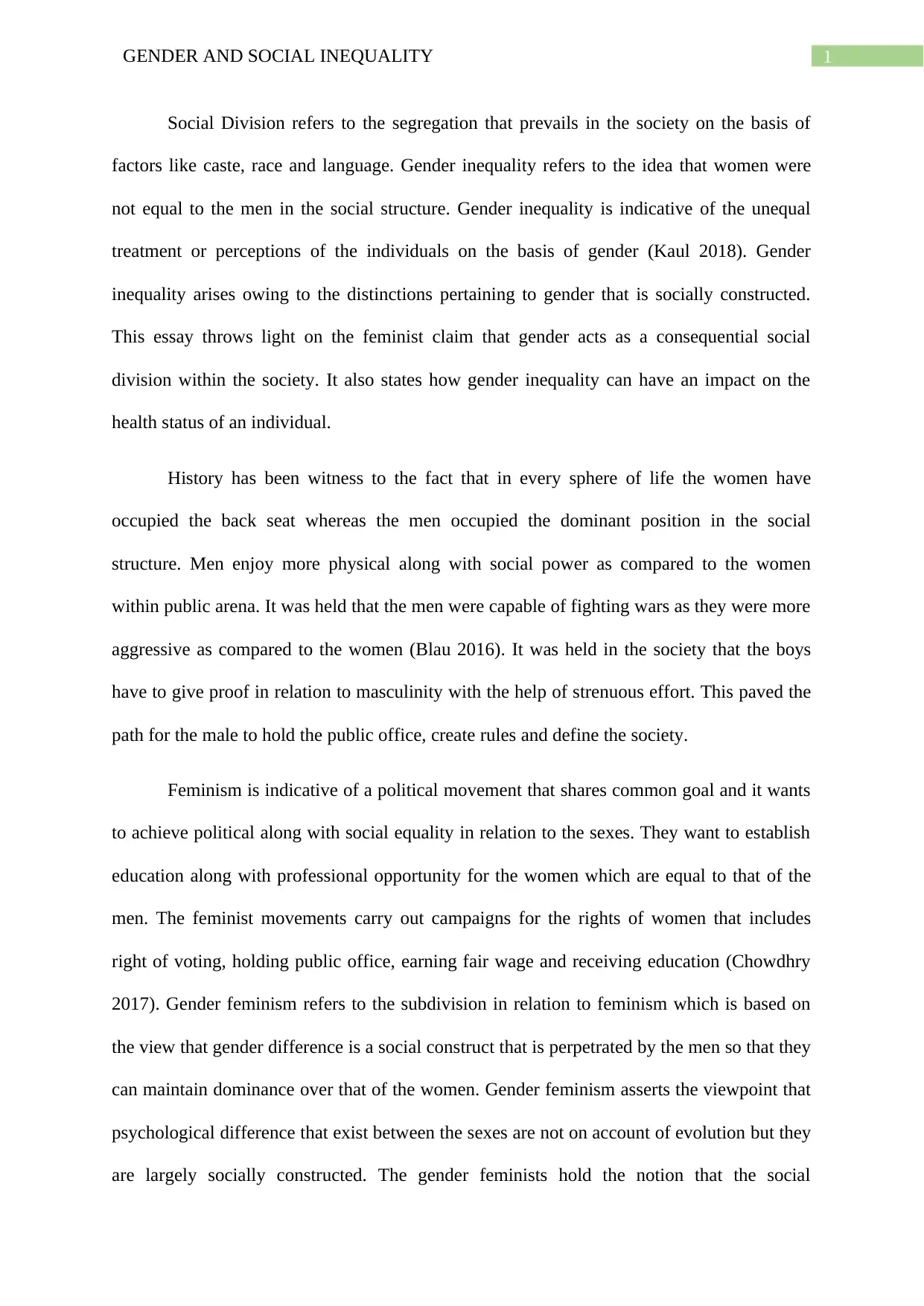
1GENDER AND SOCIAL INEQUALITY
Social Division refers to the segregation that prevails in the society on the basis of
factors like caste, race and language. Gender inequality refers to the idea that women were
not equal to the men in the social structure. Gender inequality is indicative of the unequal
treatment or perceptions of the individuals on the basis of gender (Kaul 2018). Gender
inequality arises owing to the distinctions pertaining to gender that is socially constructed.
This essay throws light on the feminist claim that gender acts as a consequential social
division within the society. It also states how gender inequality can have an impact on the
health status of an individual.
History has been witness to the fact that in every sphere of life the women have
occupied the back seat whereas the men occupied the dominant position in the social
structure. Men enjoy more physical along with social power as compared to the women
within public arena. It was held that the men were capable of fighting wars as they were more
aggressive as compared to the women (Blau 2016). It was held in the society that the boys
have to give proof in relation to masculinity with the help of strenuous effort. This paved the
path for the male to hold the public office, create rules and define the society.
Feminism is indicative of a political movement that shares common goal and it wants
to achieve political along with social equality in relation to the sexes. They want to establish
education along with professional opportunity for the women which are equal to that of the
men. The feminist movements carry out campaigns for the rights of women that includes
right of voting, holding public office, earning fair wage and receiving education (Chowdhry
2017). Gender feminism refers to the subdivision in relation to feminism which is based on
the view that gender difference is a social construct that is perpetrated by the men so that they
can maintain dominance over that of the women. Gender feminism asserts the viewpoint that
psychological difference that exist between the sexes are not on account of evolution but they
are largely socially constructed. The gender feminists hold the notion that the social
Social Division refers to the segregation that prevails in the society on the basis of
factors like caste, race and language. Gender inequality refers to the idea that women were
not equal to the men in the social structure. Gender inequality is indicative of the unequal
treatment or perceptions of the individuals on the basis of gender (Kaul 2018). Gender
inequality arises owing to the distinctions pertaining to gender that is socially constructed.
This essay throws light on the feminist claim that gender acts as a consequential social
division within the society. It also states how gender inequality can have an impact on the
health status of an individual.
History has been witness to the fact that in every sphere of life the women have
occupied the back seat whereas the men occupied the dominant position in the social
structure. Men enjoy more physical along with social power as compared to the women
within public arena. It was held that the men were capable of fighting wars as they were more
aggressive as compared to the women (Blau 2016). It was held in the society that the boys
have to give proof in relation to masculinity with the help of strenuous effort. This paved the
path for the male to hold the public office, create rules and define the society.
Feminism is indicative of a political movement that shares common goal and it wants
to achieve political along with social equality in relation to the sexes. They want to establish
education along with professional opportunity for the women which are equal to that of the
men. The feminist movements carry out campaigns for the rights of women that includes
right of voting, holding public office, earning fair wage and receiving education (Chowdhry
2017). Gender feminism refers to the subdivision in relation to feminism which is based on
the view that gender difference is a social construct that is perpetrated by the men so that they
can maintain dominance over that of the women. Gender feminism asserts the viewpoint that
psychological difference that exist between the sexes are not on account of evolution but they
are largely socially constructed. The gender feminists hold the notion that the social
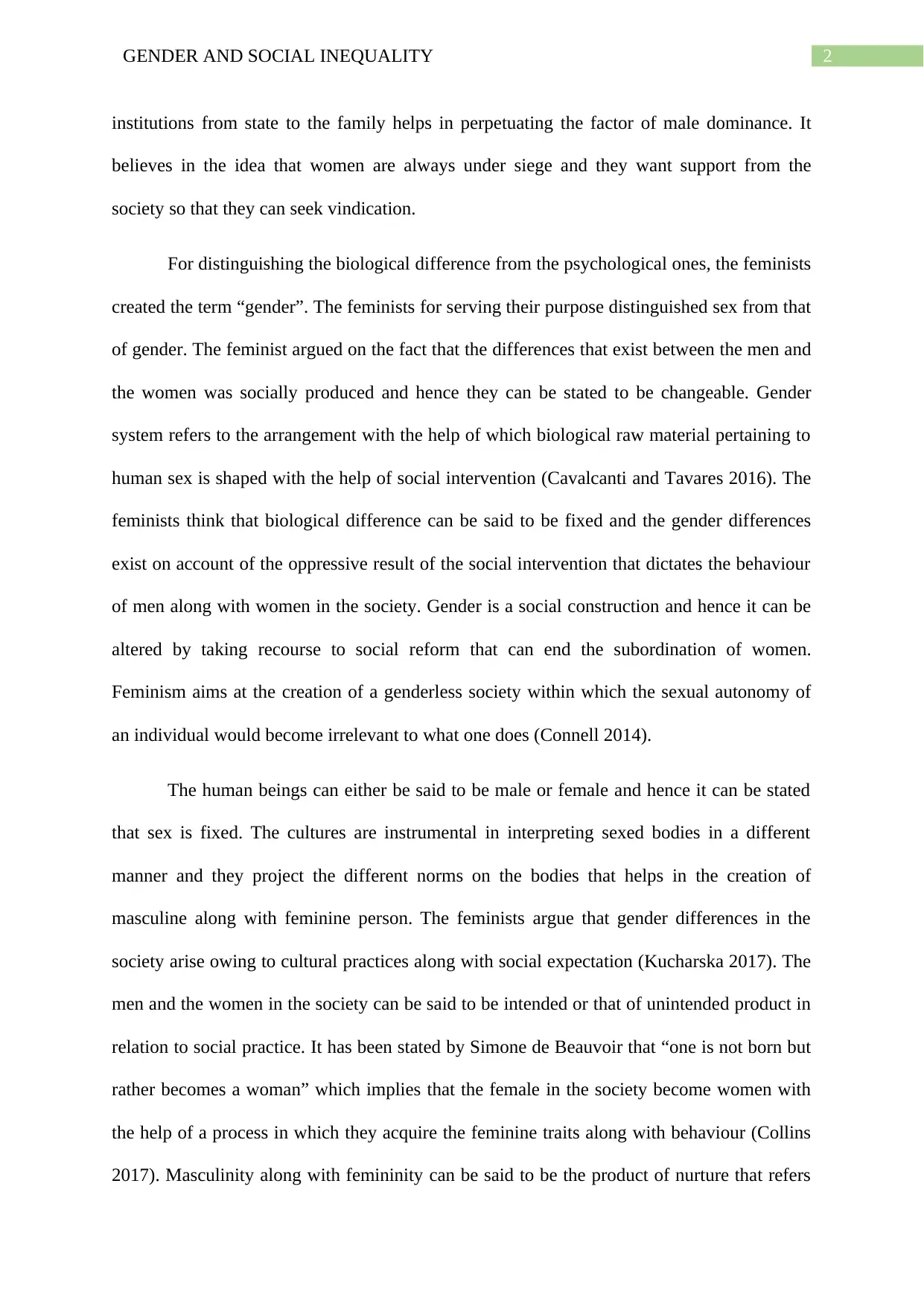
2GENDER AND SOCIAL INEQUALITY
institutions from state to the family helps in perpetuating the factor of male dominance. It
believes in the idea that women are always under siege and they want support from the
society so that they can seek vindication.
For distinguishing the biological difference from the psychological ones, the feminists
created the term “gender”. The feminists for serving their purpose distinguished sex from that
of gender. The feminist argued on the fact that the differences that exist between the men and
the women was socially produced and hence they can be stated to be changeable. Gender
system refers to the arrangement with the help of which biological raw material pertaining to
human sex is shaped with the help of social intervention (Cavalcanti and Tavares 2016). The
feminists think that biological difference can be said to be fixed and the gender differences
exist on account of the oppressive result of the social intervention that dictates the behaviour
of men along with women in the society. Gender is a social construction and hence it can be
altered by taking recourse to social reform that can end the subordination of women.
Feminism aims at the creation of a genderless society within which the sexual autonomy of
an individual would become irrelevant to what one does (Connell 2014).
The human beings can either be said to be male or female and hence it can be stated
that sex is fixed. The cultures are instrumental in interpreting sexed bodies in a different
manner and they project the different norms on the bodies that helps in the creation of
masculine along with feminine person. The feminists argue that gender differences in the
society arise owing to cultural practices along with social expectation (Kucharska 2017). The
men and the women in the society can be said to be intended or that of unintended product in
relation to social practice. It has been stated by Simone de Beauvoir that “one is not born but
rather becomes a woman” which implies that the female in the society become women with
the help of a process in which they acquire the feminine traits along with behaviour (Collins
2017). Masculinity along with femininity can be said to be the product of nurture that refers
institutions from state to the family helps in perpetuating the factor of male dominance. It
believes in the idea that women are always under siege and they want support from the
society so that they can seek vindication.
For distinguishing the biological difference from the psychological ones, the feminists
created the term “gender”. The feminists for serving their purpose distinguished sex from that
of gender. The feminist argued on the fact that the differences that exist between the men and
the women was socially produced and hence they can be stated to be changeable. Gender
system refers to the arrangement with the help of which biological raw material pertaining to
human sex is shaped with the help of social intervention (Cavalcanti and Tavares 2016). The
feminists think that biological difference can be said to be fixed and the gender differences
exist on account of the oppressive result of the social intervention that dictates the behaviour
of men along with women in the society. Gender is a social construction and hence it can be
altered by taking recourse to social reform that can end the subordination of women.
Feminism aims at the creation of a genderless society within which the sexual autonomy of
an individual would become irrelevant to what one does (Connell 2014).
The human beings can either be said to be male or female and hence it can be stated
that sex is fixed. The cultures are instrumental in interpreting sexed bodies in a different
manner and they project the different norms on the bodies that helps in the creation of
masculine along with feminine person. The feminists argue that gender differences in the
society arise owing to cultural practices along with social expectation (Kucharska 2017). The
men and the women in the society can be said to be intended or that of unintended product in
relation to social practice. It has been stated by Simone de Beauvoir that “one is not born but
rather becomes a woman” which implies that the female in the society become women with
the help of a process in which they acquire the feminine traits along with behaviour (Collins
2017). Masculinity along with femininity can be said to be the product of nurture that refers
⊘ This is a preview!⊘
Do you want full access?
Subscribe today to unlock all pages.

Trusted by 1+ million students worldwide
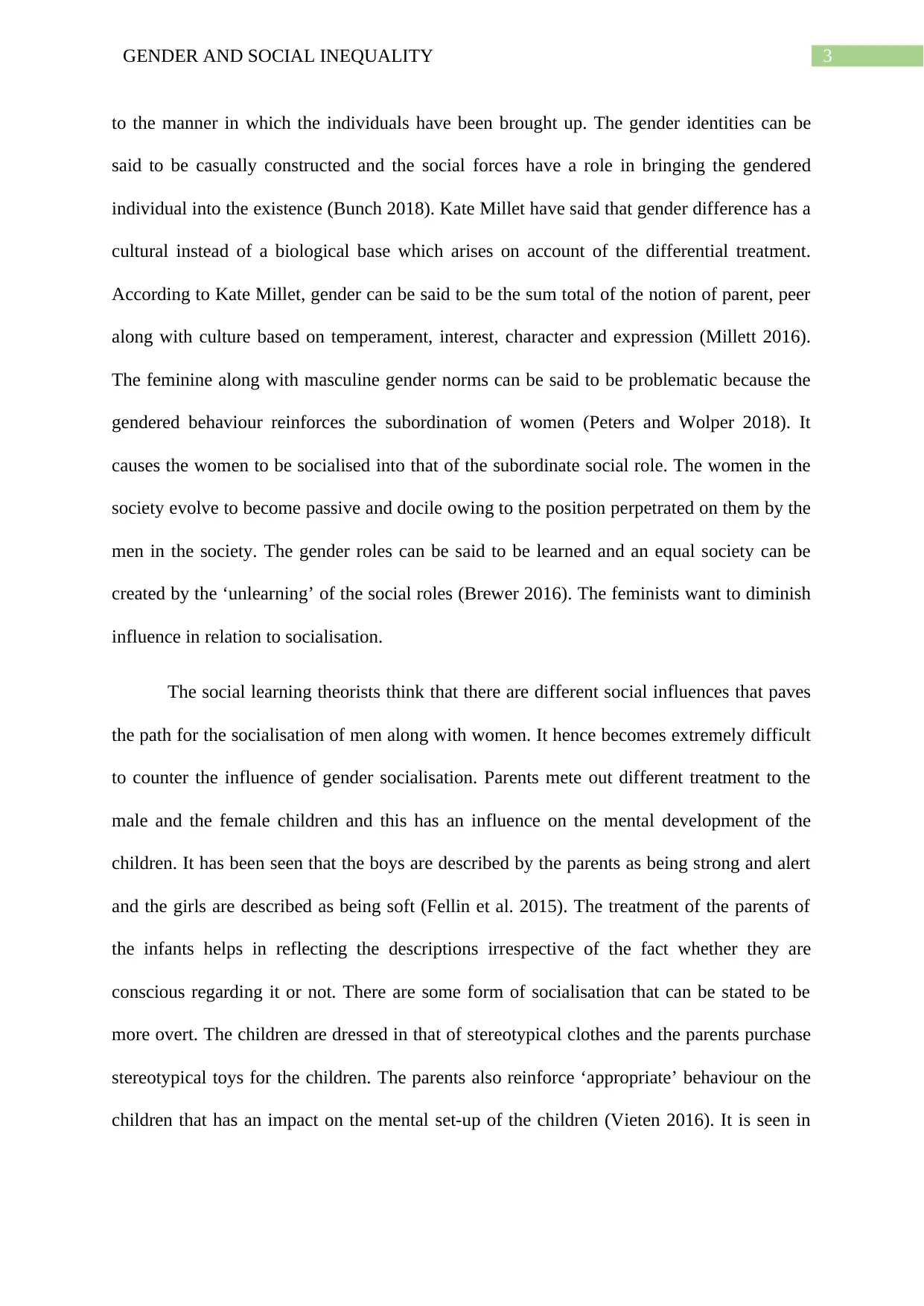
3GENDER AND SOCIAL INEQUALITY
to the manner in which the individuals have been brought up. The gender identities can be
said to be casually constructed and the social forces have a role in bringing the gendered
individual into the existence (Bunch 2018). Kate Millet have said that gender difference has a
cultural instead of a biological base which arises on account of the differential treatment.
According to Kate Millet, gender can be said to be the sum total of the notion of parent, peer
along with culture based on temperament, interest, character and expression (Millett 2016).
The feminine along with masculine gender norms can be said to be problematic because the
gendered behaviour reinforces the subordination of women (Peters and Wolper 2018). It
causes the women to be socialised into that of the subordinate social role. The women in the
society evolve to become passive and docile owing to the position perpetrated on them by the
men in the society. The gender roles can be said to be learned and an equal society can be
created by the ‘unlearning’ of the social roles (Brewer 2016). The feminists want to diminish
influence in relation to socialisation.
The social learning theorists think that there are different social influences that paves
the path for the socialisation of men along with women. It hence becomes extremely difficult
to counter the influence of gender socialisation. Parents mete out different treatment to the
male and the female children and this has an influence on the mental development of the
children. It has been seen that the boys are described by the parents as being strong and alert
and the girls are described as being soft (Fellin et al. 2015). The treatment of the parents of
the infants helps in reflecting the descriptions irrespective of the fact whether they are
conscious regarding it or not. There are some form of socialisation that can be stated to be
more overt. The children are dressed in that of stereotypical clothes and the parents purchase
stereotypical toys for the children. The parents also reinforce ‘appropriate’ behaviour on the
children that has an impact on the mental set-up of the children (Vieten 2016). It is seen in
to the manner in which the individuals have been brought up. The gender identities can be
said to be casually constructed and the social forces have a role in bringing the gendered
individual into the existence (Bunch 2018). Kate Millet have said that gender difference has a
cultural instead of a biological base which arises on account of the differential treatment.
According to Kate Millet, gender can be said to be the sum total of the notion of parent, peer
along with culture based on temperament, interest, character and expression (Millett 2016).
The feminine along with masculine gender norms can be said to be problematic because the
gendered behaviour reinforces the subordination of women (Peters and Wolper 2018). It
causes the women to be socialised into that of the subordinate social role. The women in the
society evolve to become passive and docile owing to the position perpetrated on them by the
men in the society. The gender roles can be said to be learned and an equal society can be
created by the ‘unlearning’ of the social roles (Brewer 2016). The feminists want to diminish
influence in relation to socialisation.
The social learning theorists think that there are different social influences that paves
the path for the socialisation of men along with women. It hence becomes extremely difficult
to counter the influence of gender socialisation. Parents mete out different treatment to the
male and the female children and this has an influence on the mental development of the
children. It has been seen that the boys are described by the parents as being strong and alert
and the girls are described as being soft (Fellin et al. 2015). The treatment of the parents of
the infants helps in reflecting the descriptions irrespective of the fact whether they are
conscious regarding it or not. There are some form of socialisation that can be stated to be
more overt. The children are dressed in that of stereotypical clothes and the parents purchase
stereotypical toys for the children. The parents also reinforce ‘appropriate’ behaviour on the
children that has an impact on the mental set-up of the children (Vieten 2016). It is seen in
Paraphrase This Document
Need a fresh take? Get an instant paraphrase of this document with our AI Paraphraser
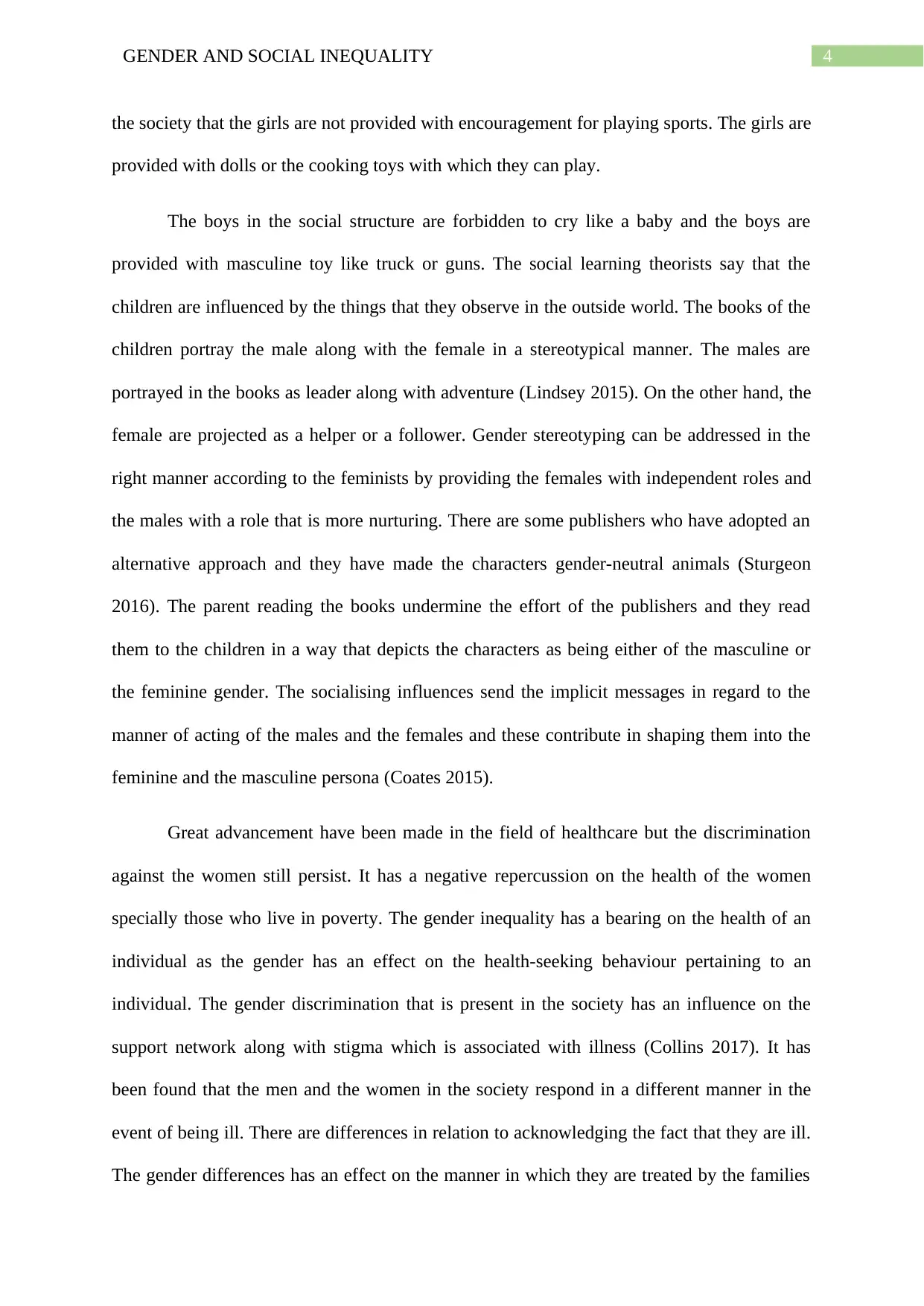
4GENDER AND SOCIAL INEQUALITY
the society that the girls are not provided with encouragement for playing sports. The girls are
provided with dolls or the cooking toys with which they can play.
The boys in the social structure are forbidden to cry like a baby and the boys are
provided with masculine toy like truck or guns. The social learning theorists say that the
children are influenced by the things that they observe in the outside world. The books of the
children portray the male along with the female in a stereotypical manner. The males are
portrayed in the books as leader along with adventure (Lindsey 2015). On the other hand, the
female are projected as a helper or a follower. Gender stereotyping can be addressed in the
right manner according to the feminists by providing the females with independent roles and
the males with a role that is more nurturing. There are some publishers who have adopted an
alternative approach and they have made the characters gender-neutral animals (Sturgeon
2016). The parent reading the books undermine the effort of the publishers and they read
them to the children in a way that depicts the characters as being either of the masculine or
the feminine gender. The socialising influences send the implicit messages in regard to the
manner of acting of the males and the females and these contribute in shaping them into the
feminine and the masculine persona (Coates 2015).
Great advancement have been made in the field of healthcare but the discrimination
against the women still persist. It has a negative repercussion on the health of the women
specially those who live in poverty. The gender inequality has a bearing on the health of an
individual as the gender has an effect on the health-seeking behaviour pertaining to an
individual. The gender discrimination that is present in the society has an influence on the
support network along with stigma which is associated with illness (Collins 2017). It has
been found that the men and the women in the society respond in a different manner in the
event of being ill. There are differences in relation to acknowledging the fact that they are ill.
The gender differences has an effect on the manner in which they are treated by the families
the society that the girls are not provided with encouragement for playing sports. The girls are
provided with dolls or the cooking toys with which they can play.
The boys in the social structure are forbidden to cry like a baby and the boys are
provided with masculine toy like truck or guns. The social learning theorists say that the
children are influenced by the things that they observe in the outside world. The books of the
children portray the male along with the female in a stereotypical manner. The males are
portrayed in the books as leader along with adventure (Lindsey 2015). On the other hand, the
female are projected as a helper or a follower. Gender stereotyping can be addressed in the
right manner according to the feminists by providing the females with independent roles and
the males with a role that is more nurturing. There are some publishers who have adopted an
alternative approach and they have made the characters gender-neutral animals (Sturgeon
2016). The parent reading the books undermine the effort of the publishers and they read
them to the children in a way that depicts the characters as being either of the masculine or
the feminine gender. The socialising influences send the implicit messages in regard to the
manner of acting of the males and the females and these contribute in shaping them into the
feminine and the masculine persona (Coates 2015).
Great advancement have been made in the field of healthcare but the discrimination
against the women still persist. It has a negative repercussion on the health of the women
specially those who live in poverty. The gender inequality has a bearing on the health of an
individual as the gender has an effect on the health-seeking behaviour pertaining to an
individual. The gender discrimination that is present in the society has an influence on the
support network along with stigma which is associated with illness (Collins 2017). It has
been found that the men and the women in the society respond in a different manner in the
event of being ill. There are differences in relation to acknowledging the fact that they are ill.
The gender differences has an effect on the manner in which they are treated by the families
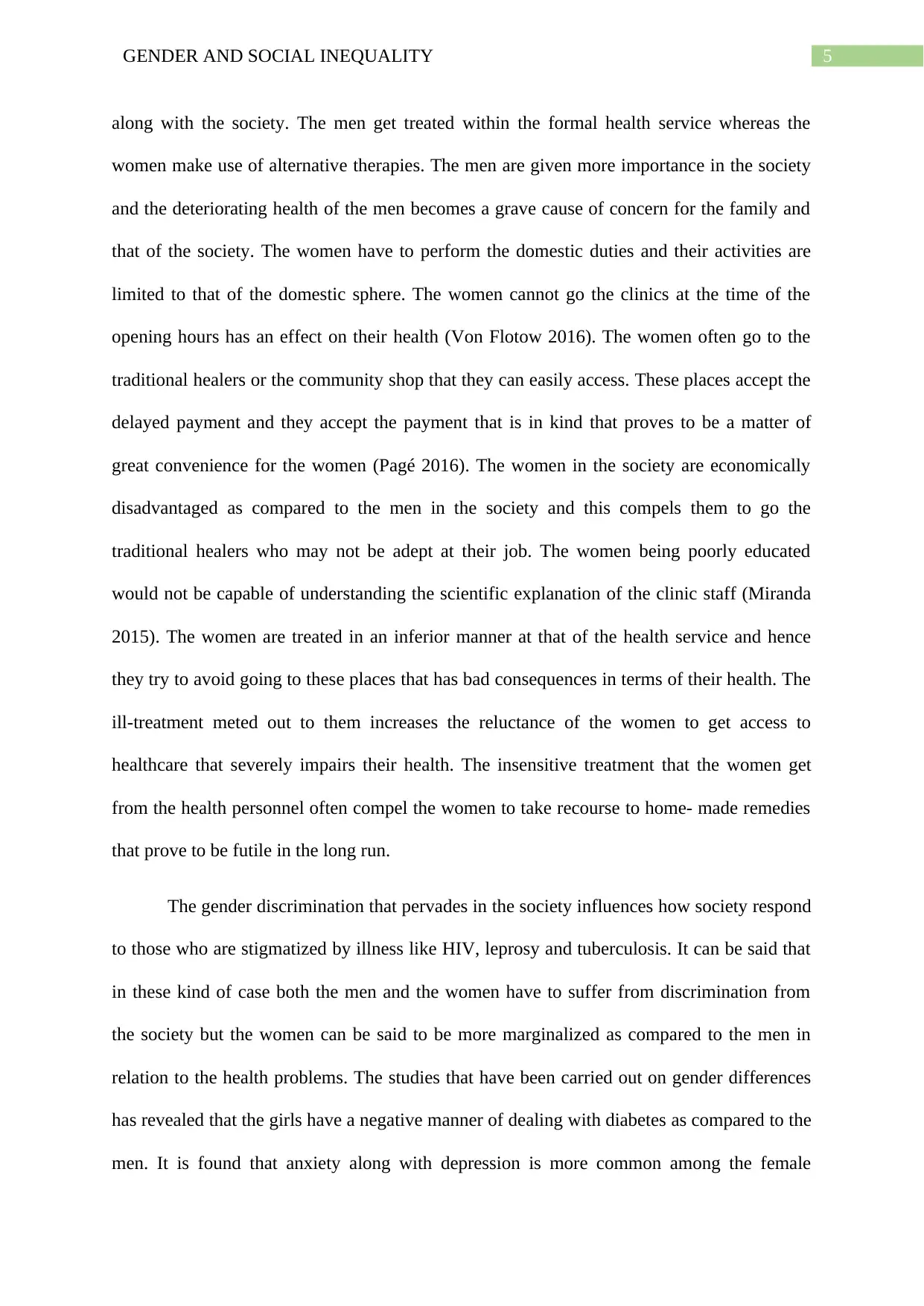
5GENDER AND SOCIAL INEQUALITY
along with the society. The men get treated within the formal health service whereas the
women make use of alternative therapies. The men are given more importance in the society
and the deteriorating health of the men becomes a grave cause of concern for the family and
that of the society. The women have to perform the domestic duties and their activities are
limited to that of the domestic sphere. The women cannot go the clinics at the time of the
opening hours has an effect on their health (Von Flotow 2016). The women often go to the
traditional healers or the community shop that they can easily access. These places accept the
delayed payment and they accept the payment that is in kind that proves to be a matter of
great convenience for the women (Pagé 2016). The women in the society are economically
disadvantaged as compared to the men in the society and this compels them to go the
traditional healers who may not be adept at their job. The women being poorly educated
would not be capable of understanding the scientific explanation of the clinic staff (Miranda
2015). The women are treated in an inferior manner at that of the health service and hence
they try to avoid going to these places that has bad consequences in terms of their health. The
ill-treatment meted out to them increases the reluctance of the women to get access to
healthcare that severely impairs their health. The insensitive treatment that the women get
from the health personnel often compel the women to take recourse to home- made remedies
that prove to be futile in the long run.
The gender discrimination that pervades in the society influences how society respond
to those who are stigmatized by illness like HIV, leprosy and tuberculosis. It can be said that
in these kind of case both the men and the women have to suffer from discrimination from
the society but the women can be said to be more marginalized as compared to the men in
relation to the health problems. The studies that have been carried out on gender differences
has revealed that the girls have a negative manner of dealing with diabetes as compared to the
men. It is found that anxiety along with depression is more common among the female
along with the society. The men get treated within the formal health service whereas the
women make use of alternative therapies. The men are given more importance in the society
and the deteriorating health of the men becomes a grave cause of concern for the family and
that of the society. The women have to perform the domestic duties and their activities are
limited to that of the domestic sphere. The women cannot go the clinics at the time of the
opening hours has an effect on their health (Von Flotow 2016). The women often go to the
traditional healers or the community shop that they can easily access. These places accept the
delayed payment and they accept the payment that is in kind that proves to be a matter of
great convenience for the women (Pagé 2016). The women in the society are economically
disadvantaged as compared to the men in the society and this compels them to go the
traditional healers who may not be adept at their job. The women being poorly educated
would not be capable of understanding the scientific explanation of the clinic staff (Miranda
2015). The women are treated in an inferior manner at that of the health service and hence
they try to avoid going to these places that has bad consequences in terms of their health. The
ill-treatment meted out to them increases the reluctance of the women to get access to
healthcare that severely impairs their health. The insensitive treatment that the women get
from the health personnel often compel the women to take recourse to home- made remedies
that prove to be futile in the long run.
The gender discrimination that pervades in the society influences how society respond
to those who are stigmatized by illness like HIV, leprosy and tuberculosis. It can be said that
in these kind of case both the men and the women have to suffer from discrimination from
the society but the women can be said to be more marginalized as compared to the men in
relation to the health problems. The studies that have been carried out on gender differences
has revealed that the girls have a negative manner of dealing with diabetes as compared to the
men. It is found that anxiety along with depression is more common among the female
⊘ This is a preview!⊘
Do you want full access?
Subscribe today to unlock all pages.

Trusted by 1+ million students worldwide
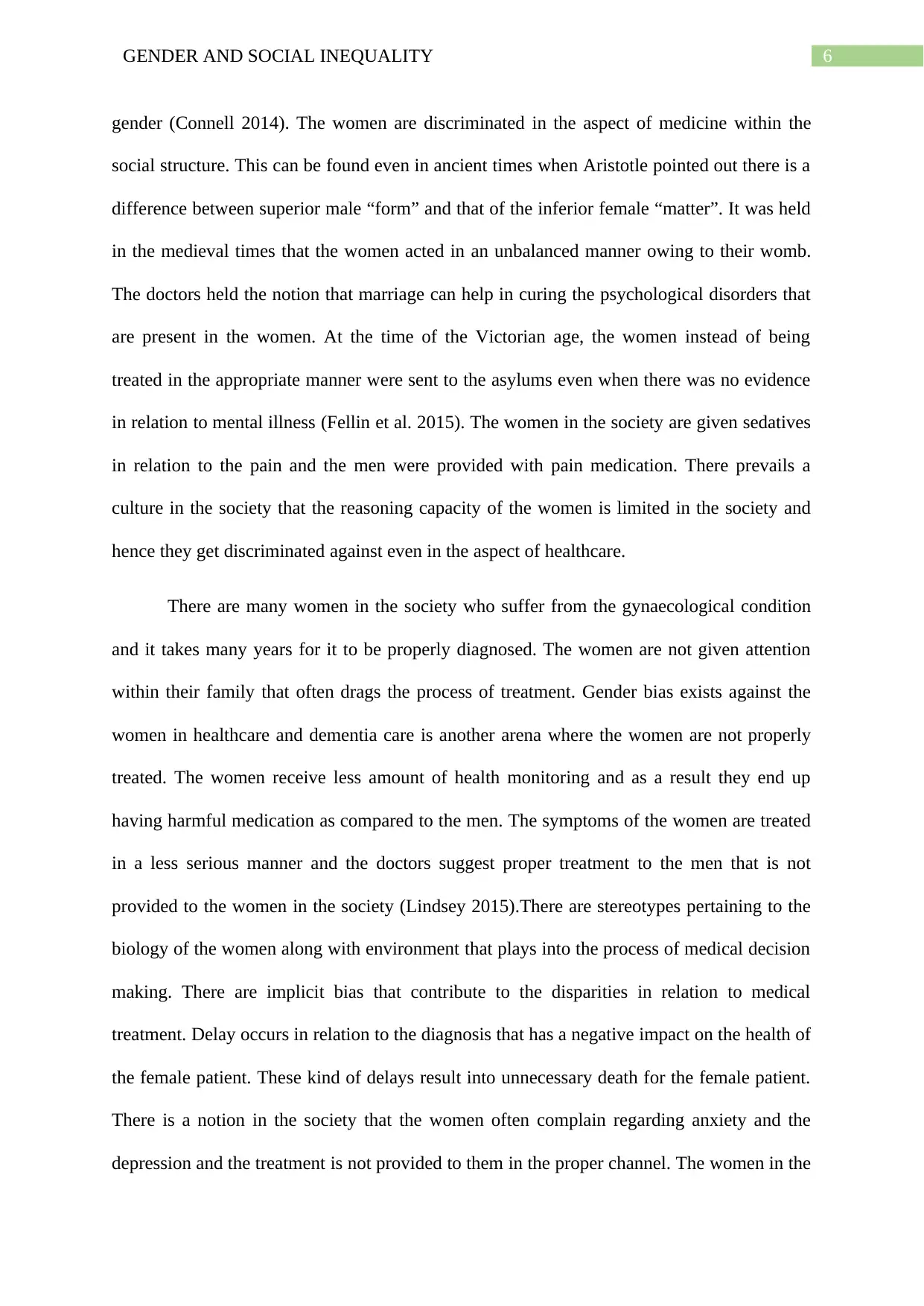
6GENDER AND SOCIAL INEQUALITY
gender (Connell 2014). The women are discriminated in the aspect of medicine within the
social structure. This can be found even in ancient times when Aristotle pointed out there is a
difference between superior male “form” and that of the inferior female “matter”. It was held
in the medieval times that the women acted in an unbalanced manner owing to their womb.
The doctors held the notion that marriage can help in curing the psychological disorders that
are present in the women. At the time of the Victorian age, the women instead of being
treated in the appropriate manner were sent to the asylums even when there was no evidence
in relation to mental illness (Fellin et al. 2015). The women in the society are given sedatives
in relation to the pain and the men were provided with pain medication. There prevails a
culture in the society that the reasoning capacity of the women is limited in the society and
hence they get discriminated against even in the aspect of healthcare.
There are many women in the society who suffer from the gynaecological condition
and it takes many years for it to be properly diagnosed. The women are not given attention
within their family that often drags the process of treatment. Gender bias exists against the
women in healthcare and dementia care is another arena where the women are not properly
treated. The women receive less amount of health monitoring and as a result they end up
having harmful medication as compared to the men. The symptoms of the women are treated
in a less serious manner and the doctors suggest proper treatment to the men that is not
provided to the women in the society (Lindsey 2015).There are stereotypes pertaining to the
biology of the women along with environment that plays into the process of medical decision
making. There are implicit bias that contribute to the disparities in relation to medical
treatment. Delay occurs in relation to the diagnosis that has a negative impact on the health of
the female patient. These kind of delays result into unnecessary death for the female patient.
There is a notion in the society that the women often complain regarding anxiety and the
depression and the treatment is not provided to them in the proper channel. The women in the
gender (Connell 2014). The women are discriminated in the aspect of medicine within the
social structure. This can be found even in ancient times when Aristotle pointed out there is a
difference between superior male “form” and that of the inferior female “matter”. It was held
in the medieval times that the women acted in an unbalanced manner owing to their womb.
The doctors held the notion that marriage can help in curing the psychological disorders that
are present in the women. At the time of the Victorian age, the women instead of being
treated in the appropriate manner were sent to the asylums even when there was no evidence
in relation to mental illness (Fellin et al. 2015). The women in the society are given sedatives
in relation to the pain and the men were provided with pain medication. There prevails a
culture in the society that the reasoning capacity of the women is limited in the society and
hence they get discriminated against even in the aspect of healthcare.
There are many women in the society who suffer from the gynaecological condition
and it takes many years for it to be properly diagnosed. The women are not given attention
within their family that often drags the process of treatment. Gender bias exists against the
women in healthcare and dementia care is another arena where the women are not properly
treated. The women receive less amount of health monitoring and as a result they end up
having harmful medication as compared to the men. The symptoms of the women are treated
in a less serious manner and the doctors suggest proper treatment to the men that is not
provided to the women in the society (Lindsey 2015).There are stereotypes pertaining to the
biology of the women along with environment that plays into the process of medical decision
making. There are implicit bias that contribute to the disparities in relation to medical
treatment. Delay occurs in relation to the diagnosis that has a negative impact on the health of
the female patient. These kind of delays result into unnecessary death for the female patient.
There is a notion in the society that the women often complain regarding anxiety and the
depression and the treatment is not provided to them in the proper channel. The women in the
Paraphrase This Document
Need a fresh take? Get an instant paraphrase of this document with our AI Paraphraser
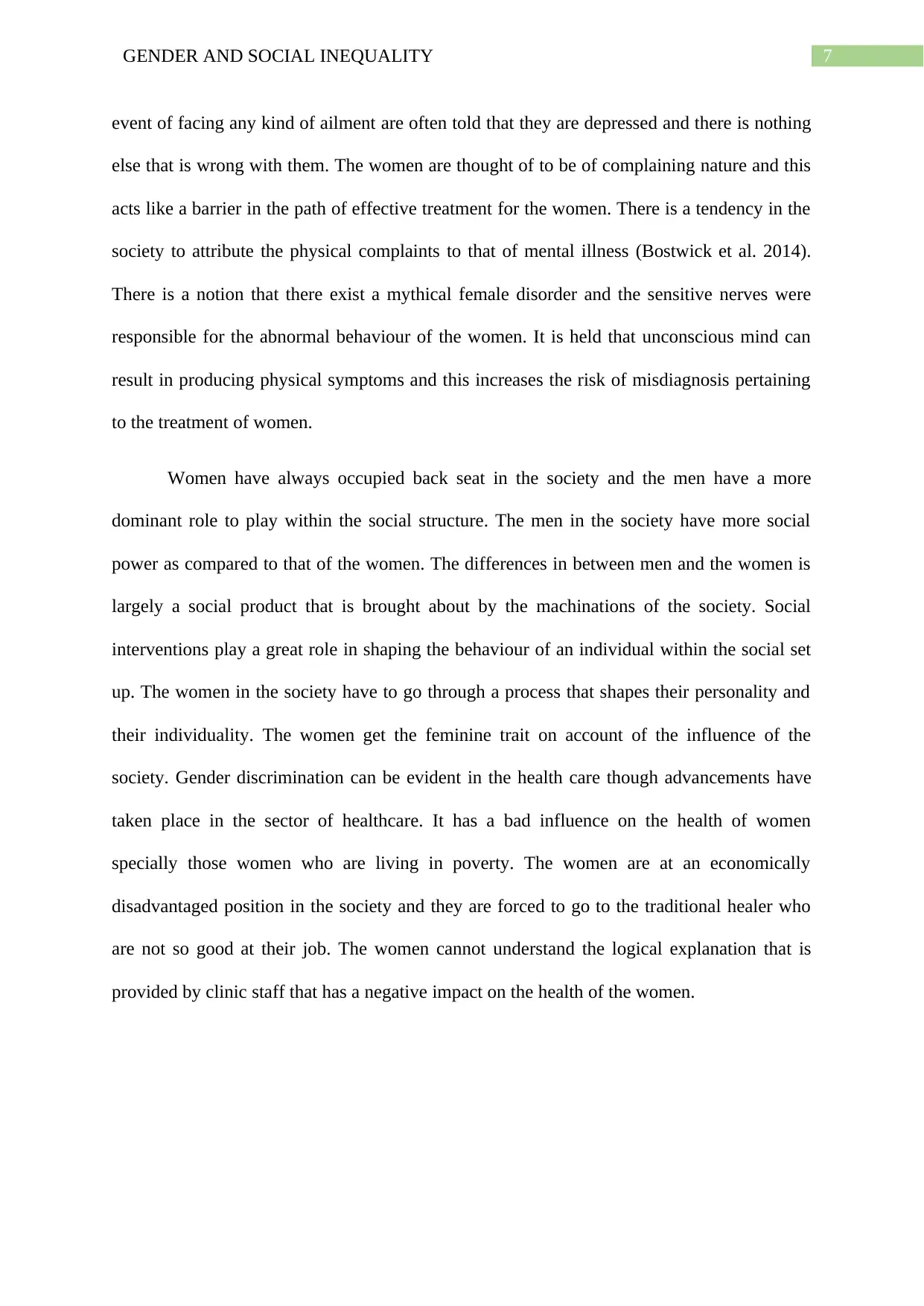
7GENDER AND SOCIAL INEQUALITY
event of facing any kind of ailment are often told that they are depressed and there is nothing
else that is wrong with them. The women are thought of to be of complaining nature and this
acts like a barrier in the path of effective treatment for the women. There is a tendency in the
society to attribute the physical complaints to that of mental illness (Bostwick et al. 2014).
There is a notion that there exist a mythical female disorder and the sensitive nerves were
responsible for the abnormal behaviour of the women. It is held that unconscious mind can
result in producing physical symptoms and this increases the risk of misdiagnosis pertaining
to the treatment of women.
Women have always occupied back seat in the society and the men have a more
dominant role to play within the social structure. The men in the society have more social
power as compared to that of the women. The differences in between men and the women is
largely a social product that is brought about by the machinations of the society. Social
interventions play a great role in shaping the behaviour of an individual within the social set
up. The women in the society have to go through a process that shapes their personality and
their individuality. The women get the feminine trait on account of the influence of the
society. Gender discrimination can be evident in the health care though advancements have
taken place in the sector of healthcare. It has a bad influence on the health of women
specially those women who are living in poverty. The women are at an economically
disadvantaged position in the society and they are forced to go to the traditional healer who
are not so good at their job. The women cannot understand the logical explanation that is
provided by clinic staff that has a negative impact on the health of the women.
event of facing any kind of ailment are often told that they are depressed and there is nothing
else that is wrong with them. The women are thought of to be of complaining nature and this
acts like a barrier in the path of effective treatment for the women. There is a tendency in the
society to attribute the physical complaints to that of mental illness (Bostwick et al. 2014).
There is a notion that there exist a mythical female disorder and the sensitive nerves were
responsible for the abnormal behaviour of the women. It is held that unconscious mind can
result in producing physical symptoms and this increases the risk of misdiagnosis pertaining
to the treatment of women.
Women have always occupied back seat in the society and the men have a more
dominant role to play within the social structure. The men in the society have more social
power as compared to that of the women. The differences in between men and the women is
largely a social product that is brought about by the machinations of the society. Social
interventions play a great role in shaping the behaviour of an individual within the social set
up. The women in the society have to go through a process that shapes their personality and
their individuality. The women get the feminine trait on account of the influence of the
society. Gender discrimination can be evident in the health care though advancements have
taken place in the sector of healthcare. It has a bad influence on the health of women
specially those women who are living in poverty. The women are at an economically
disadvantaged position in the society and they are forced to go to the traditional healer who
are not so good at their job. The women cannot understand the logical explanation that is
provided by clinic staff that has a negative impact on the health of the women.
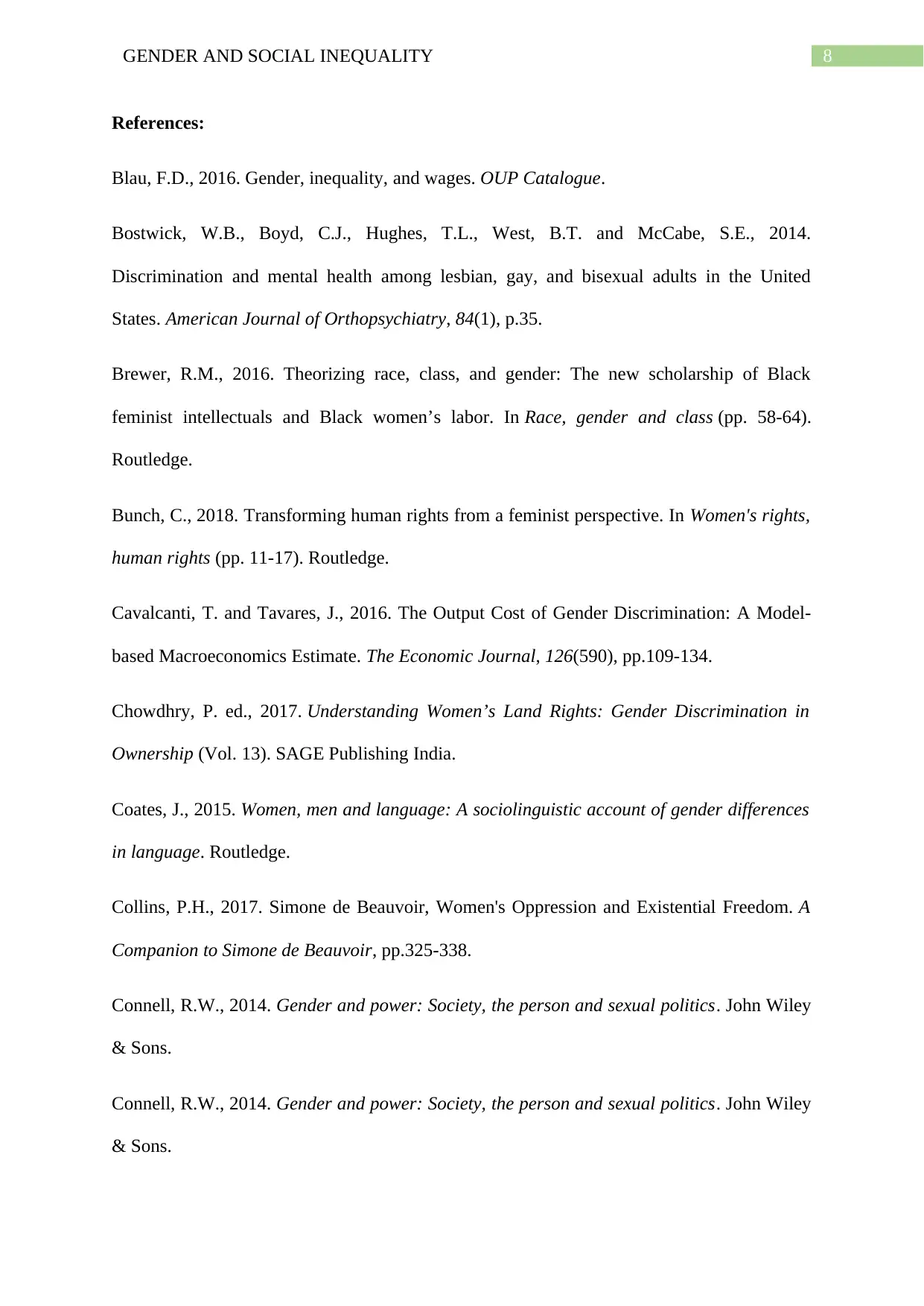
8GENDER AND SOCIAL INEQUALITY
References:
Blau, F.D., 2016. Gender, inequality, and wages. OUP Catalogue.
Bostwick, W.B., Boyd, C.J., Hughes, T.L., West, B.T. and McCabe, S.E., 2014.
Discrimination and mental health among lesbian, gay, and bisexual adults in the United
States. American Journal of Orthopsychiatry, 84(1), p.35.
Brewer, R.M., 2016. Theorizing race, class, and gender: The new scholarship of Black
feminist intellectuals and Black women’s labor. In Race, gender and class (pp. 58-64).
Routledge.
Bunch, C., 2018. Transforming human rights from a feminist perspective. In Women's rights,
human rights (pp. 11-17). Routledge.
Cavalcanti, T. and Tavares, J., 2016. The Output Cost of Gender Discrimination: A Model‐
based Macroeconomics Estimate. The Economic Journal, 126(590), pp.109-134.
Chowdhry, P. ed., 2017. Understanding Women’s Land Rights: Gender Discrimination in
Ownership (Vol. 13). SAGE Publishing India.
Coates, J., 2015. Women, men and language: A sociolinguistic account of gender differences
in language. Routledge.
Collins, P.H., 2017. Simone de Beauvoir, Women's Oppression and Existential Freedom. A
Companion to Simone de Beauvoir, pp.325-338.
Connell, R.W., 2014. Gender and power: Society, the person and sexual politics. John Wiley
& Sons.
Connell, R.W., 2014. Gender and power: Society, the person and sexual politics. John Wiley
& Sons.
References:
Blau, F.D., 2016. Gender, inequality, and wages. OUP Catalogue.
Bostwick, W.B., Boyd, C.J., Hughes, T.L., West, B.T. and McCabe, S.E., 2014.
Discrimination and mental health among lesbian, gay, and bisexual adults in the United
States. American Journal of Orthopsychiatry, 84(1), p.35.
Brewer, R.M., 2016. Theorizing race, class, and gender: The new scholarship of Black
feminist intellectuals and Black women’s labor. In Race, gender and class (pp. 58-64).
Routledge.
Bunch, C., 2018. Transforming human rights from a feminist perspective. In Women's rights,
human rights (pp. 11-17). Routledge.
Cavalcanti, T. and Tavares, J., 2016. The Output Cost of Gender Discrimination: A Model‐
based Macroeconomics Estimate. The Economic Journal, 126(590), pp.109-134.
Chowdhry, P. ed., 2017. Understanding Women’s Land Rights: Gender Discrimination in
Ownership (Vol. 13). SAGE Publishing India.
Coates, J., 2015. Women, men and language: A sociolinguistic account of gender differences
in language. Routledge.
Collins, P.H., 2017. Simone de Beauvoir, Women's Oppression and Existential Freedom. A
Companion to Simone de Beauvoir, pp.325-338.
Connell, R.W., 2014. Gender and power: Society, the person and sexual politics. John Wiley
& Sons.
Connell, R.W., 2014. Gender and power: Society, the person and sexual politics. John Wiley
& Sons.
⊘ This is a preview!⊘
Do you want full access?
Subscribe today to unlock all pages.

Trusted by 1+ million students worldwide
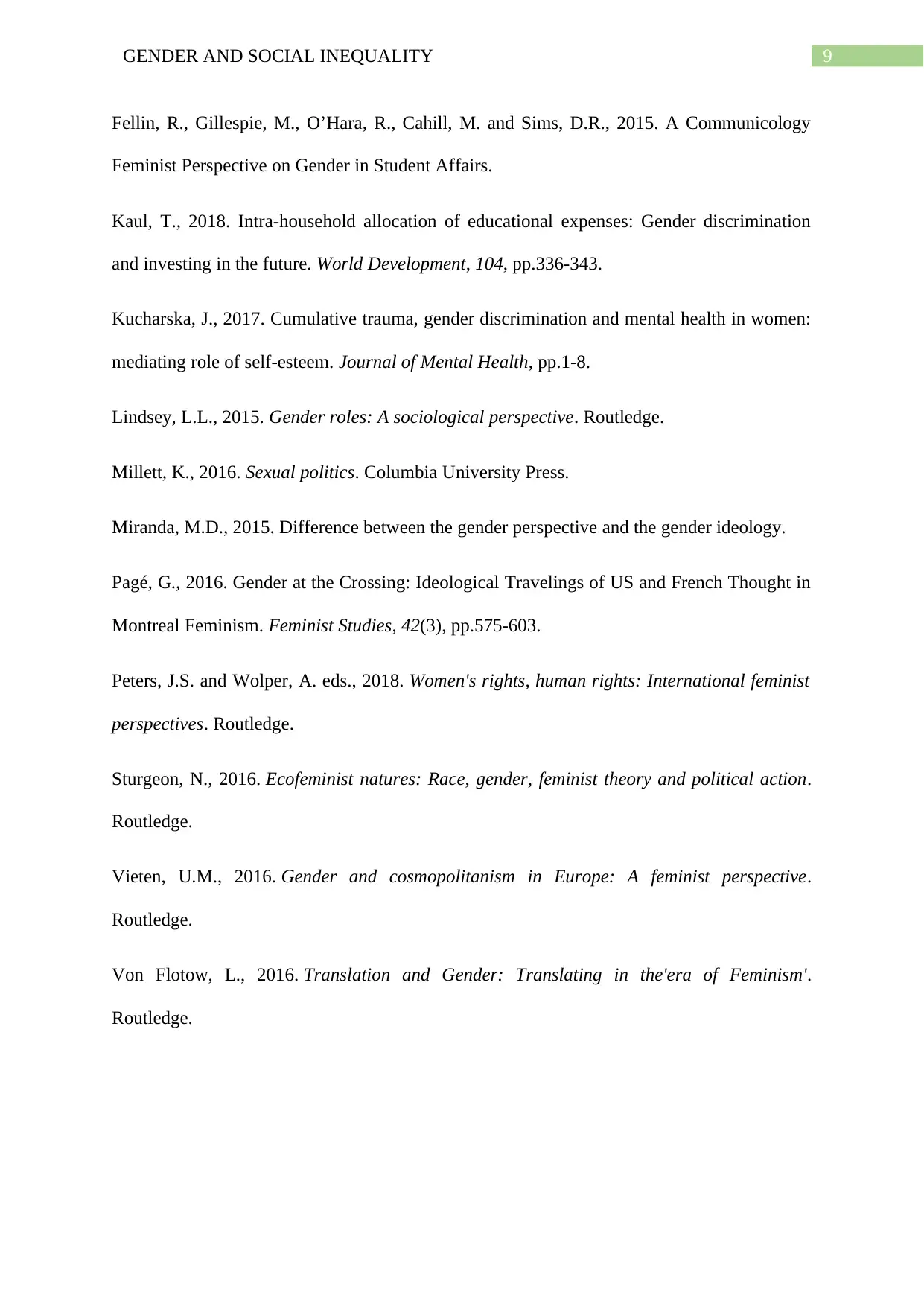
9GENDER AND SOCIAL INEQUALITY
Fellin, R., Gillespie, M., O’Hara, R., Cahill, M. and Sims, D.R., 2015. A Communicology
Feminist Perspective on Gender in Student Affairs.
Kaul, T., 2018. Intra-household allocation of educational expenses: Gender discrimination
and investing in the future. World Development, 104, pp.336-343.
Kucharska, J., 2017. Cumulative trauma, gender discrimination and mental health in women:
mediating role of self-esteem. Journal of Mental Health, pp.1-8.
Lindsey, L.L., 2015. Gender roles: A sociological perspective. Routledge.
Millett, K., 2016. Sexual politics. Columbia University Press.
Miranda, M.D., 2015. Difference between the gender perspective and the gender ideology.
Pagé, G., 2016. Gender at the Crossing: Ideological Travelings of US and French Thought in
Montreal Feminism. Feminist Studies, 42(3), pp.575-603.
Peters, J.S. and Wolper, A. eds., 2018. Women's rights, human rights: International feminist
perspectives. Routledge.
Sturgeon, N., 2016. Ecofeminist natures: Race, gender, feminist theory and political action.
Routledge.
Vieten, U.M., 2016. Gender and cosmopolitanism in Europe: A feminist perspective.
Routledge.
Von Flotow, L., 2016. Translation and Gender: Translating in the'era of Feminism'.
Routledge.
Fellin, R., Gillespie, M., O’Hara, R., Cahill, M. and Sims, D.R., 2015. A Communicology
Feminist Perspective on Gender in Student Affairs.
Kaul, T., 2018. Intra-household allocation of educational expenses: Gender discrimination
and investing in the future. World Development, 104, pp.336-343.
Kucharska, J., 2017. Cumulative trauma, gender discrimination and mental health in women:
mediating role of self-esteem. Journal of Mental Health, pp.1-8.
Lindsey, L.L., 2015. Gender roles: A sociological perspective. Routledge.
Millett, K., 2016. Sexual politics. Columbia University Press.
Miranda, M.D., 2015. Difference between the gender perspective and the gender ideology.
Pagé, G., 2016. Gender at the Crossing: Ideological Travelings of US and French Thought in
Montreal Feminism. Feminist Studies, 42(3), pp.575-603.
Peters, J.S. and Wolper, A. eds., 2018. Women's rights, human rights: International feminist
perspectives. Routledge.
Sturgeon, N., 2016. Ecofeminist natures: Race, gender, feminist theory and political action.
Routledge.
Vieten, U.M., 2016. Gender and cosmopolitanism in Europe: A feminist perspective.
Routledge.
Von Flotow, L., 2016. Translation and Gender: Translating in the'era of Feminism'.
Routledge.
1 out of 10
Related Documents
Your All-in-One AI-Powered Toolkit for Academic Success.
+13062052269
info@desklib.com
Available 24*7 on WhatsApp / Email
![[object Object]](/_next/static/media/star-bottom.7253800d.svg)
Unlock your academic potential
Copyright © 2020–2025 A2Z Services. All Rights Reserved. Developed and managed by ZUCOL.





